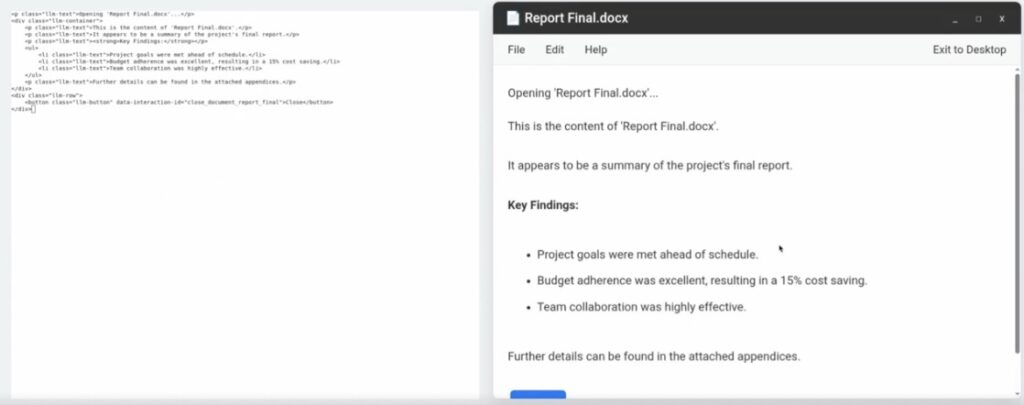A Glimpse into the Future of On-Demand User Interfaces with Low-Cost, High-Speed AI
- Gemini 2.5 Flash-Lite introduces a groundbreaking approach to user interfaces by generating ephemeral GUIs on demand, tailored to specific tasks in real-time.
- This low-cost, low-latency model excels in high-volume tasks like translation and classification, while outperforming its predecessor, 2.0 Flash-Lite, across multiple benchmarks.
- Despite its innovative potential, the current demo carries a “horseless carriage” vibe, mimicking conventional UI designs rather than fully embracing the new paradigm.

Imagine a world where the user interface you interact with isn’t static or pre-designed, but instead materializes instantly, crafted specifically for the task at hand. This isn’t science fiction—it’s the reality being shaped by Gemini 2.5 Flash-Lite, a cutting-edge thinking model that’s redefining how we engage with technology. In a recent demo, this AI showcased its ability to generate a completely ephemeral GUI (Graphical User Interface) based solely on the context of the previous screen. With just the click of a button, the model writes the code for both the UI and its contents in real-time, delivering a seamless experience that feels both futuristic and, oddly, a bit nostalgic.
Let’s unpack this “horseless carriage” feel first. Much like early automobiles mimicked the design of horse-drawn carriages, the current demo of Gemini 2.5 Flash-Lite’s GUI generation clings to conventional UI layouts. It’s a cool proof of concept, no doubt, but it also highlights how we’re still in the early stages of adapting to this new paradigm. The true potential lies in breaking free from traditional designs and creating interfaces that are not just functional but intuitively aligned with the user’s immediate needs. Imagine a UI that morphs as you work, anticipating your next step without a single preset template in sight. That’s the high-level idea behind this technology, and while the demo may feel a tad silly in its mimicry, it’s a stepping stone to something truly transformative.
What makes Gemini 2.5 Flash-Lite stand out isn’t just its ability to whip up a GUI on the fly—it’s the model’s overall performance and accessibility. Designed for those seeking low-cost and low-latency solutions, this AI is a game-changer for high-volume, latency-sensitive tasks. Whether it’s translation, classification, or other repetitive processes, 2.5 Flash-Lite handles them with remarkable efficiency. This makes it an ideal choice for businesses or developers who need reliable performance without breaking the bank. And for those already familiar with its predecessor, 2.0 Flash-Lite, the upgrade is a no-brainer. Benchmarks show that 2.5 Flash-Lite offers significantly higher performance across a wide range of categories, including coding, math, science, reasoning, and even multimodal tasks that blend text and visual data.
The implications of this technology are vast. For developers, it means faster prototyping and deployment of applications with interfaces that adapt dynamically to user context. For end-users, it promises a more personalized and responsive digital experience, where the tools you use feel like they were made just for you, right in the moment you need them. The speed at which Gemini 2.5 Flash-Lite operates—generating complex UI code in the time it takes to click a button—is nothing short of astonishing. It’s not just about saving time; it’s about reimagining how we interact with machines, making technology feel less like a rigid tool and more like a fluid extension of our intent.
Of course, there’s room to grow. The current demo, while impressive, is a reminder that we’re still tethered to old ways of thinking about design. The “horseless carriage” analogy isn’t just a critique—it’s a call to action. As we move forward with models like Gemini 2.5 Flash-Lite, the challenge will be to let go of outdated frameworks and embrace the full potential of ephemeral, context-driven interfaces. What if your next app didn’t just adapt to your screen size or preferences, but to the very task you’re trying to accomplish in that exact moment? That’s the future this technology hints at, and it’s an exciting one.
Gemini 2.5 Flash-Lite is already a powerful tool for those ready to explore this frontier. Its blend of affordability, speed, and enhanced performance across diverse benchmarks makes it a compelling upgrade over 2.0 Flash-Lite. Whether you’re a developer looking to streamline high-volume tasks or simply curious about the next wave of AI-driven innovation, this model offers a tantalizing glimpse into what’s possible.
